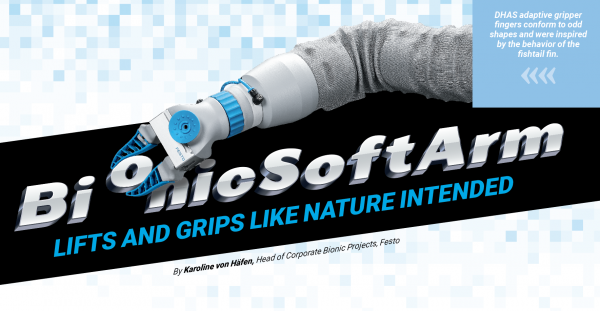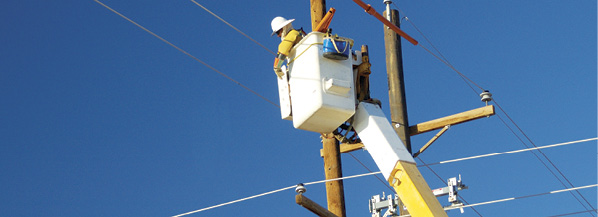Basic Vacuum Pump Choice
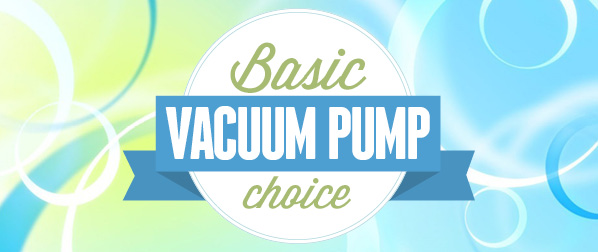
The consideration of which vacuum pump to select is based on many factors. This article explains the fundamental differences between three very common vacuum pump technologies and offers the user a better understanding of what their selection differences are.
More often than not, a vacuum user will replace an existing vacuum pump with the exact same one they used before. If this vacuum pump works, then all is well, right? Well, possibly. Just because the vacuum pump works for the application doesn’t necessarily mean it was the best pump choice.
The age-old saying of “If it’s not broken, don’t try to fix it” is a common route to undertake and understandably so. But if you have the opportunity to improve it, due to a new installation or faulty pump replacement, then this is the time to get a better understanding of what is actually required of the new pumping equipment.
So to offer some real-life pump choices, let’s compare obvious pump technologies with each other based on typical performance metrics and also the comparative “goods and bads” of using one type of pump over another.
Rotary Sliding Vane
In general industry, rotary sliding vane pumps, as shown in Fig. 1 and Fig. 2, are very popular, offering the user a good vacuum flow choice from only 1 cfm to beyond 1000 cfm. There are two fundamental choices of rotary sliding vane pumps: one being oil lubricated (Fig. 1) and the other being oil-free (Fig. 2). This description is self-explanatory, but one choice should be selected over the other for one main reason: if you need a higher vacuum level, then choose an oil-lubricated pump. If you don’t need a high vacuum level and if 27″Hg (which is the same as 90 kPa, 100 mbar(a), 76 Torr, or 76 mmHg) is adequate, then do not use a lubricated pump.
Why, you might ask, don’t you use a pump that is capable of a high vacuum level but use it at a lower one? It’s a fair question, and the answer is because a typical oiled vacuum pump requires a higher vacuum level to stay lubricated. Oil is “pulled” through the vacuum pump under vacuum. Therefore, if you are using an oiled pump at a consistently low vacuum, particularly below 20″Hg, lubrication of the pump will be poor, possibly resulting in damage or even seizure. Another reason is that at a lower vacuum level, an oiled pump could possibly start to “smoke” from the exhaust. This is because the amount of air passing through the pump at a low vacuum level is greater than what the pump’s internal air/oil separator is rated for. Consequently, excessive oil vapor is forced through the filter and creates an oil mist, or smoke, at the pump exhaust.

Just because you found an old oiled pump that isn’t being used doesn’t mean it should be. Understand what vacuum level you will generate before pump selection.
Don’t forget that it’s not the pump that determines the final vacuum level; it’s the application. If your application is sealed or dead-headed without any external leaks from the atmosphere, then the pump being used will generate its maximum design vacuum level. However, if your system is not airtight—and most aren’t—such as vacuum cup lifting of cardboard cartons, then the pump most likely will not reach its final design vacuum level.
If a vacuum system is not generating as high a vacuum level as it was the day before, it’s rarely the fault of the pump. Any air entering the vacuum system will decrease the final vacuum level being pumped down.
So, rotary vane pumps. Oil-free models (not lubricated) can be used in the majority of applications requiring a 20-27“Hg vacuum degree. These would be applications such as vacuum cup lifting, paper sheet conveying, end-of-arm vacuum grippers, universal vacuum tooling, carton palletizing, and so on.
Oiled or lubricated vacuum pumps should be selected for applications where a higher vacuum level is needed, such as vacuum packaging of meats, cheese packaging, vacuum-packed foods and similar products, degassing of liquids, adhesive curing, vacuum clamping, vacuum plastination, vacuum molding, and so on. A typical maximum vacuum level of an oil-lubricated rotary vane pump would be in excess of 29″Hg. Of course, using “Hg as the measurement unit is not appropriate, as this is a differential vacuum level measurement. In higher vacuum level applications, an absolute scale such as mmHg or mbar(a) should be used. Most oil-lubricated models will achieve an absolute pressure of 0.5 mmHG or 0.5 Torr. Some models, designed specifically for high vacuum process applications achieve absolute pressure in the region of 1 x 10-2 mmHg (0.01 mmHg).
Diaphragm Pumps
Diaphragm pumps, as shown in Fig. 3, are normally associated with lower flow vacuum applications, such as standalone medical devices or dental surgeries. Although able to generate vacuum levels in the region of 28.5″Hg, they have a lower flow rate capability compared to rotary vane pumps, topping out at about 4-5 cfm. This is due to the oscillating pumping motion of the diaphragm. A rotary vane pump can spin incredibly fast and has a high surface speed (flow rate) at the vane tip. The reciprocating nature of a diaphragm pump might also be undesirable to the user in respect to the pulsating sound emitted.
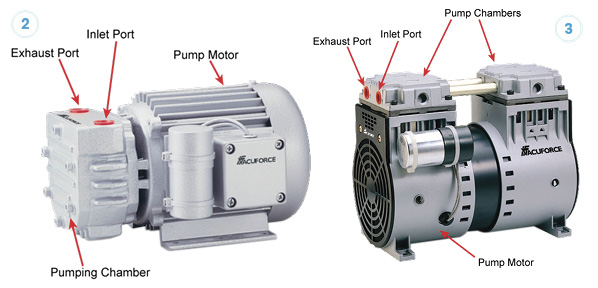
However, many DC motor diaphragm pumps are available, and this is ideal for mobile equipment and also low-voltage standalone machinery. The compact size of the diaphragm pump and DC motor option lends itself to mobile equipment in particular. The diaphragm membrane and pump head is available in a host of materials to aid the user application, and because of this, diaphragm pumps are often used in gas-sampling applications where the pump “sucks” air in and then “blows” it out to be analyzed or tested with zero contamination of the media. This is not possible with rotary vane pumps due to oil contamination and vane wear particulates in oiled and dry pumps respectively.
Regenerative Blowers
Regenerative blowers, as shown in Fig. 4 and Fig. 5, sometimes referred to as “side channel” blowers particularly in Europe, offer very large vacuum flow rates per kW motor power used compared to rotary vane pumps due to the high speed impeller design. As with most things in life, you always have to trade one thing for something else, and in the case of blowers, the final vacuum level achieved could be regarded as poor by some, particularly compared to diaphragm and rotary vane pumps.
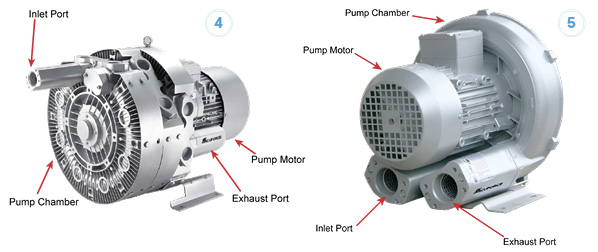
However, the vacuum level is certainly not the be-all and end-all in vacuum-lifting and material-transfer applications. The vacuum level does not have to be very high. A single-stage regenerative blower has a typical maximum vacuum level of about 6-8“Hg, as shown in Fig. 4, although some manufacturers offer 2-stage or 3-stage models with final vacuum levels in excess of 21“Hg. Fig. 4 and Fig. 5 show a single and a two-stage model respectively. Notice the position of the exhaust port, which visually indicates whether the pump is single or 2-stage.
Regenerative blowers also offer a virtually maintenance-free operation except for occasional bearing changes, and if used in conjunction with the correct accessories, such as a vacuum-relief valve, bleeds air into the blower inlet to prevent “over vacuum.” Remember: just because a blower can generate a vacuum of 18″Hg does not mean it’s designed to do so!
Fig. 6 illustrates the general comparison of these three pump technologies in respect to their maximum vacuum level and maximum flow rate abilities. Fig. 7 illustrates a comparison of the most popular measurement units used in vacuum generation.
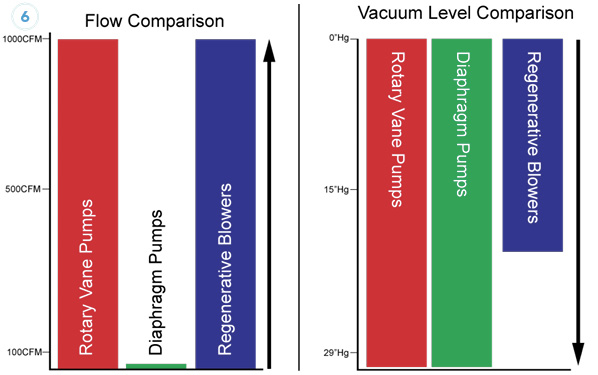
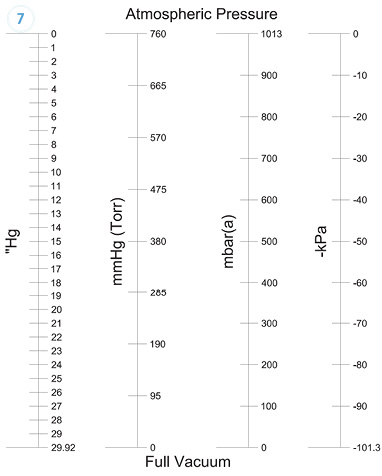
This article is intended as a general guide, and as with any industrial application involving machinery choice, independent professional advice should be sought to ensure correct selection and installation.
Vacuforce LLC is a manufacturer and distributor of vacuum components and systems for industry in North America. Vacuforce can be reached via their website at www.vacuforce.com or directly at sales@vacuforce.com. Illustrations supplied by Daniel Pascoe of Davasol Inc, an industrial distribution branding company. Mr. Pascoe can be reached at dpascoe@davasol.com.


